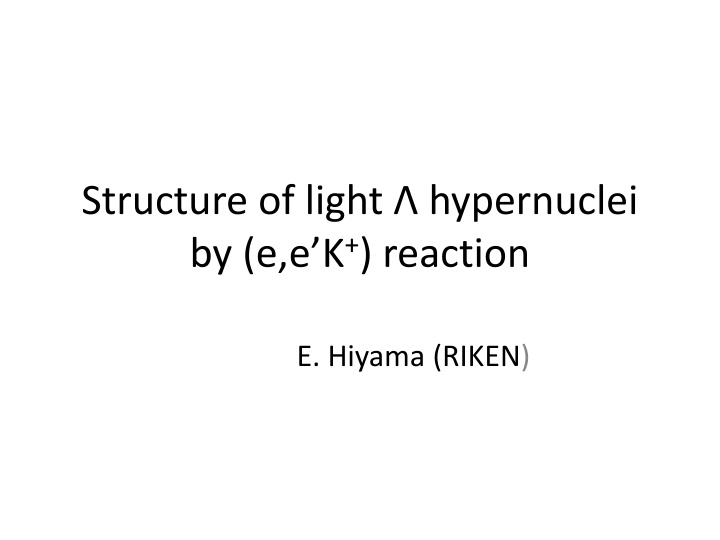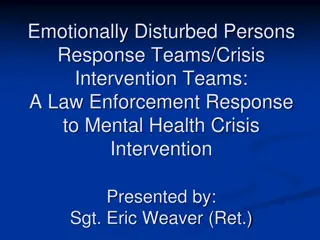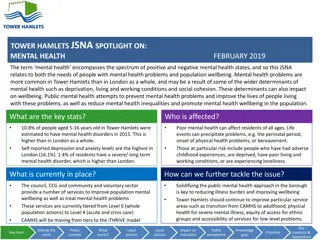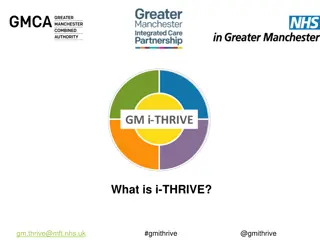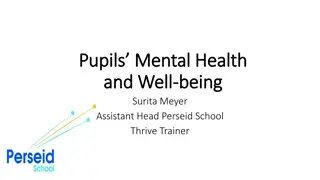Supporting Mental Health Awareness in Young People
Young people with good mental health can feel in control of their emotions, have good cognitive functions, and positive interactions. Mental illness can impact their thinking, emotional state, daily activities, and relationships. National statistics highlight the prevalence of diagnosable mental health conditions among children and young people, emphasizing the importance of early intervention and support. Schools provide various resources and support systems to address mental health challenges, promoting a safe and nurturing environment. Being mindful of peers, noticing signs of distress, and offering support can make a significant difference in promoting mental well-being.
Download Presentation

Please find below an Image/Link to download the presentation.
The content on the website is provided AS IS for your information and personal use only. It may not be sold, licensed, or shared on other websites without obtaining consent from the author.If you encounter any issues during the download, it is possible that the publisher has removed the file from their server.
You are allowed to download the files provided on this website for personal or commercial use, subject to the condition that they are used lawfully. All files are the property of their respective owners.
The content on the website is provided AS IS for your information and personal use only. It may not be sold, licensed, or shared on other websites without obtaining consent from the author.
E N D
Presentation Transcript
Structure of light hypernuclei by (e,e K+) reaction E. Hiyama (RIKEN)
Using these targets, we have these light hypernucei by (e, e K+) reaction at Jlab. Here I will focus on these hypernuclei. n n p n n n n n n 4He n p n 4He 7Li 3n 3H 7He n p n n n p n n 4He 4He 4He 4He 4He 4He 6 Li 6 He 10Be 10B Resultant hypernucleus Resultant hypernucleus target target
Outline (1) Introduction n (2) n n n n n 4He 4He 4He 4He 3n 6 He 7He 10Be These hypernuclei can be produced by (e, e K+) at Jlab. What is interesting and important to study these hypernuclei?
Major goals of hypernuclear physics 1) To understand baryon-baryon interactions 2) To study the structure of multi-strangeness systems In order to understand the baryon-baryon interaction, two-body scattering experiment is most useful. Study of NN intereaction has been developed. Total number of Nucleon (N) -Nucleon (N) data: 4,000 YN and YY potential models so far proposed (ex. Nijmegen, Julich, Kyoto-Niigata) have large ambiguity. Total number of differential cross section Hyperon (Y) -Nucleon (N) data: 40 NO YY scattering data since it is difficult to perform YN scattering experiment even at J-PARC.
2) To study the structure of multi-strangeness systems Hypernucleus = nn n Many-body system of neutrons, protons, hyperons p n p n Y n n p p Y Once the Hamiltonian is determined, it is possible , using few-body calculation method (Gaussian Expansion Method), to precisely calculate the structure of many-body systems consisting of neutrons, protons and hyperons. As a result, we can predict new phenomena such as we have never imagined before.
No Pauli principle Between N and particle can reach deep inside, and attract the surrounding nucleons towards the interior of the nucleus. N Due to the attraction of N interaction, the resultant hypernucleus will become more stable against the neutron decay. Hypernucleus neutron decay threshold nucleus hypernucleus
Nuclear chart with strangeness Multi-strangeness system such as Neutron star Extending drip-line! Interesting phenomena concerning the neutron halo have been observed near the neutron drip line of light nuclei. How is structure change when a particle is injected into neutron-rich nuclei ?
Question: How is structure change when a particle is injected into neutron-rich nuclei ? n n n n 7He 3n JLAB experiment-E011, Phys. Rev. Lett. 110, 12502 (2013). C. Rappold et al., HypHI collaboration Phys. Rev. C 88, 041001 (R) (2013) n 6He
Section 2 three-body calculation of3n E. Hiyama, S. Ohnishi, B.F. Gibson, and T. A. Rijken, The paper will be publised in PRC as a Rapid communication soon. n n
What is interesting to study nn system? n n S=0 The lightest nucleus to have a bound state is deuteron. n+p threshold n p J=1+ d -2.22 MeV Exp. S=-1 ( hypernucear sector) n+p+ Lightest hypernucleus to have a bound state p d+ n 3H (hyper-triton) 0.13 MeV J=1/2+ Exp.
-23.7fm nn breakup threshold n n ? They did not report the binding energy. scattering length:-2.68fm Observation of nn system (2013) Lightest hypernucleus to have a bound state
Theoretical important issue: Do we have bound state for nn system? If we have a bound state for this system, how much is binding energy? nn breakup threshold n n ? They did not report the binding energy. NN interaction : to reproduce the observed binding energies of 3H and 3He NN: AV8 potential We do not include 3-body force for nuclear sector. How about YN interaction?
Non-strangeness nuclei N Nucleon can be converted into . However, since mass difference between nucleon and is large, then probability of in nucleus is not large. N N On the other hand, the mass difference between and is much smaller, then can be converted into particle easily. 300MeV N N 80MeV N
To take into account of particle to be converted into particle, we should perform below calculation using realistic hyperon(Y)-nucleon(N) interaction. n n n n + YN interaction: Nijmegen soft core 97f potential (NSC97f) proposed by Nijmegen group reproduce the observed binding energies of 3H, 4H and 4He
-B d+ 0 MeV p n 3H 1/2+ 1/2+ -0.19 MeV Cal. -0.13 0.05 MeV Exp.
p n 4He 4H n n -B p 4He p -B 4H 3He+ 0 MeV 0 MeV 3H+ 1+ 1+ 1+ 1+ -0.57 -0.54 -1.24 -1.00 0+ 0+ 0+ 0+ -2.04 -2.39 Exp. -2.28 Cal. -2.33 Cal. Exp. What is binding energy of nn ?
-B 1/2+ nn threshold n n 0 MeV We have no bound state in nn system. This is inconsistent with the data. Now, we have a question. Do we have a possibility to have a bound state in nn system tuning strength of YN potential ? It should be noted to maintain consistency with the binding energies of 3H and 4H and 4He. VT N- N X1.1, 1.2
n n VT N- N VT N- N X1.2 X1.1 When we have a bound state in nn system, what are binding energies of 3H and A=4 hypernuclei?
n p n n We have no possibility to have a bound state in nn system. n n p
Question: If we tune 1S0state of nn interaction, Do we have a possibility to have a bound state in nn ? In this case, the binding energies of 3H and 3He reproduce the observed data? Some authors pointed out to have dineutron bound state in nn system. Ex. H. Witala and W. Gloeckle, Phys. Rev. C85, 064003 (2012). T=1, 1S0state I multiply component of 1S0state by 1.13 and 1.35. What is the binding energies of nn n n
n n unbound nn 0 MeV -0.066MeV -1.269 MeV 1S0X1.13 1S0X1.35 unbound unbound 0 MeV n n nn 1/2+ -1.272 MeV We do not find any possibility to have a bound state in nn . N+N+N 3H (3He) -7.77(-7.12) -8.48 (-7.72) -9.75 (-9.05) -13.93 (-13.23)MeV 1/2+ Exp. Cal. 1/2+ Cal. Cal.
Summary of nn system: Motivated by the reported observation of data suggesting a bound state nn , we have calculated the binding energy of this hyperucleus taking into account N- N explicitly. We did not find any possibility to have a bound state in this system. However, the experimentally they reported evidence for a bound state. As long as we believe the data, we should consider additional missing elements in the present calculation. But, I have no idea. Unfortunately, they did not report binding energy. Then, I would like to suggest experimentalists: To perform search experiment of nn system to conclude whether or not the system exists as bound state experimentally. n n n n 3n 3H n p (e,e K+)
6He n 6He
P3/2 0.89 MeV +n+ 0 MeV +n 5He 5He+n -3.12 MeV 0.17 MeV 1- 6He n L=0 5He Valence neutron is very loosely coupled to the + system. 6He Question: Can we reproduce the data ? How do the 3 particle locate to each other? Is there neutron halo in 6He hypernucleus?
^ n(r) = | (6He)|2dRdr r n Three-layer structure r.m.s - 2.8 fm -n 5.0 fm Larger than 6He Halo nucleus 6He -n 4.5 fm
7He n n 7He
n n 6He : One of the lightest n-rich nuclei 6He n n 7He: One of the lightest n-rich hypernuclei 7He Observed at JLAB, Phys. Rev. Lett. 110, 12502 (2013).
CAL: E. Hiyama et al., PRC 53, 2075 (1996), PRC 80, 054321 (2009) 6He 7He 2+ + +n+n 0 MeV 0 MeV +n+n One of the excited state was observed at Jlab. 5He+n+n 0+ Exp:-0.98 -1.03 MeV Neutron halo states 5/2+ 3/2+ -4.57 1/2+ Observed at J-Lab experiment Phys. Rev. Lett.110, 012502 (2013). -6.19 MeV
7Li(e,eK+)7He At present, due to poor statics, It is difficult to have the third peak. Theoretically, is it possible to have new state? Let s consider it. Third peak? (FWHM = 1.3 MeV) Fitting results
12.1 1.1 MeV (2+,1-,0+)? 2.5 MeV = =113 20 keV = 1.797 MeV 2+ 1.79 MeV 0 MeV +n+n -0.98 0+ -0.97 MeV theory 6He Exp. Myo et al., PRC 84, 064306 (2011). Core nucleus
7He n n 7He + +n+n 0 MeV New prediction -1.88 =0.7 MeV -2.04, =0.5 MeV 5/2+ 3/2+ 5He+n+n Neutron halo states -3.12 5/2+ 3/2+ -4.57 1/2+ -6.19 MeV
7He 12.1 1.1 MeV (2+,1-,0+)? If we find these two excited states at Jlab, in 6He, existence of the second 2+state is promising. Please search the second 2+ state in 7He at Jlab. 2+ 1.797 MeV 2+ =113 20 keV + +n+n 0 MeV 0 MeV +n+n -1.88 =0.7 MeV -2.04, =0.5 MeV 5/2+ 3/2+ -0.98 0+ 5He+n+n Neutron halo states -3.12 5/2+ 6He 3/2+ -4.57 Exp. 1/2+ If we find these two states at Jlab, these existence contribute to unstable nuclear physics. -6.19 MeV
Section 3 Response of super-deformed states by addition of particle 10Be
What happens when a particle is added to such ND and SD states? Super-deformed (SD) spherical Normal deformed (ND) We have various kinds of nuclear shape, such as spherical, normal deformed and super-deformed shapes. Especially, it is known that super-deformed shape is related to the appearance of a large shell gap at a 2:1 axis ratio of the nuclear deformation for specific particle numbers.
What happens when a particle is added to such ND and SD states? Super- deformed (SD) states Does energy gain go in parallel way for both types of states? Normal Deformed (ND) states No ! 2+2 0+2 2+1 2+2 0+1 0+2 core nucleus 2+1 0+1 hypernucleus
Energy gain by -particle addition E(ND state) > E(SD state) ND state SD state ND state Level crossing core nucleus One example in hypernucleus 10Be
10Be 10Be 9Be Y. Zang, E. H., and Y. Yamamoto, Nucl. Phys. A 881, 288 (2012): E. H. and Y. Yamamoto, Prog. Theor. Phys. 128, 105, (2012).
Interesting phenomena such as level crossing is seen in 9Be and 10Be combination. It is well known that , in the 1/2+state, a valence neutron is located in 1S 1/2orbit in the simple shell model configuration. It is a kind of SD state. ND 5/2- SD 1/2+ + +n When a particle is injected into each state, is there any change of energy spectra? ND 3/2- 9Be 10Be
MeV 5/2 +0.6 MeV 1/2+ +0.1 ND SD Level reversion is occurred by addition of a particle. 3/2 - -1.58 9Be ND 10B(e,e K+)10Be (Jlab E01-11) Small spin-splitting is neglected to show. If we observe positive states and negative states, we find that -separation energies are dependent on the degree of deformation. Please observe the positive parity states at Jlab. -7.35 0+ , 1+ 2-, 3- -8.14 -10.52 MeV 10Be 1-, 2-
Summary n n p n n n n n n 4He n 4He n p 7Li 7He 3n 3H Please observe second 3/2+and 5/2+state. This is important for the study of neutron-rich nuclei. Please confirm whether or not we have bound state, n p n n n p n n 4He 4He 4He 4He 4He 4He 6 Li 10Be 10B 6 He Please observe the positive parity state. It is interesting to have a huge halo structure.
In this way, the experiment at Jlab is very important for theorists to study the structure of multi-strangeness systems. I hope we have many data at Jlab in the future.
